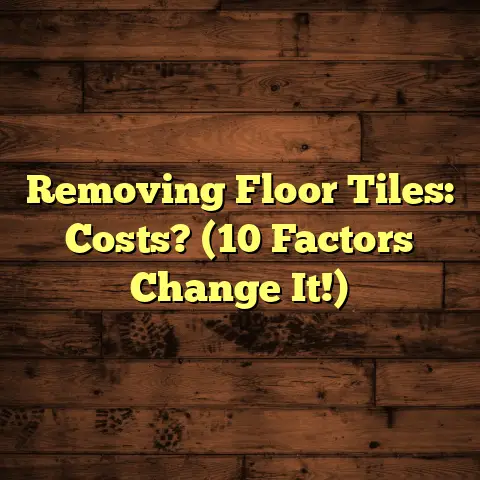Roof Replacement Signs (7 Urgent Leaks!)
As a flooring contractor, you might be wondering why I’m talking about roofs. Well, let me tell you, water damage from a leaky roof can wreak havoc on everything below it, including your beautiful floors! Trust me, I’ve seen the aftermath, and it’s not pretty. That’s why I’m passionate about helping you protect your biggest investment: your home.
A safe and secure home is the foundation of a good life, right? It’s where we raise families, create memories, and find comfort. And at the very top of it all, quite literally, is your roof. It’s your home’s first line of defense against the elements, and when it fails, the consequences can be devastating.
A leaky roof isn’t just a minor inconvenience. It can disrupt your daily life with annoying drips and buckets. It can lead to health hazards from mold and mildew. And it can drain your bank account with costly repairs.
Ignoring roofing issues is like ignoring a toothache – it might seem manageable at first, but it will only get worse (and more expensive) over time. That’s why awareness and timely action are crucial for responsible homeownership.
In this article, I’m going to share with you seven urgent signs that your roof needs serious attention – possibly even a replacement. We’re talking about potential leaks that can cause major damage if left untreated. I’ll walk you through what to look for, what the consequences are, and what to do about it.
Think of me as your friendly neighborhood contractor, here to help you keep your home safe, dry, and valuable. Let’s get started!
Section 1: Understanding Roof Functionality
Okay, let’s start with the basics. What does your roof actually do? It’s more than just a cover, you know.
First and foremost, it provides weather protection. Rain, snow, wind, hail – your roof shields your home from all of it. Without a solid roof, your house would be exposed to the elements, leading to rot, water damage, and structural problems.
Your roof also provides insulation. It helps regulate the temperature inside your home, keeping it cooler in the summer and warmer in the winter. A well-insulated roof can significantly reduce your energy bills.
And last but not least, your roof provides structural support. It’s an integral part of your home’s framework, helping to hold everything together. A damaged roof can compromise the structural integrity of your entire house.
Roofing Materials 101
Roofs are made from a variety of materials, each with its own pros and cons. Here are some of the most common:
-
Asphalt Shingles: These are the most popular choice for residential roofs in North America. They’re affordable, durable, and relatively easy to install. According to the Asphalt Roofing Manufacturers Association (ARMA), asphalt shingles account for over 75% of residential roofing installations.
-
Metal Roofing: Metal roofs are known for their longevity and durability. They can last for 50 years or more, and they’re resistant to fire, wind, and impact. While more expensive upfront, they can save you money in the long run due to their long lifespan.
-
Tile Roofing: Tile roofs are a beautiful and durable option, often seen in warmer climates. They’re fire-resistant and can last for over 100 years. However, they’re also heavy and require specialized installation.
-
Wood Shingles and Shakes: Wood roofs have a natural, rustic look. They’re also environmentally friendly. However, they require regular maintenance and are more susceptible to fire and rot.
Roof Types and Their Vulnerabilities
Roofs come in all shapes and sizes, each with its own unique characteristics and potential weaknesses.
-
Pitched Roofs: These are the most common type of roof, characterized by their sloping design. The pitch (or slope) of the roof affects how well it sheds water and snow. Common vulnerabilities include shingle damage from wind and hail, and leaks around flashing.
-
Flat Roofs: Flat roofs are often found on commercial buildings, but they can also be used on residential homes. They have a slight slope to allow for water runoff. Common vulnerabilities include ponding water, which can lead to leaks and membrane damage.
-
Gable Roofs: Gable roofs are a type of pitched roof with two sloping sides that meet at a ridge. Vulnerabilities include wind damage to the gable ends and leaks around the ridge.
-
Hip Roofs: Hip roofs have four sloping sides that meet at a ridge. They’re more resistant to wind damage than gable roofs. Vulnerabilities include leaks around the hips (the corners where the sloping sides meet).
Understanding your roof’s functionality, materials, and type is the first step in identifying potential problems and preventing costly damage.
Section 2: Common Causes of Roof Leaks
So, what causes roofs to leak in the first place? Here are some of the most common culprits:
-
Wear and Tear from Weather Elements: Sun, wind, rain, snow, hail – your roof endures a constant barrage of weather elements. Over time, this can cause shingles to crack, curl, or lose their granules. According to the National Roofing Contractors Association (NRCA), weather-related damage is the leading cause of roof leaks.
-
Poor Installation: A poorly installed roof is a recipe for disaster. If the shingles aren’t properly fastened, or if the flashing isn’t correctly installed, leaks are almost inevitable. I’ve seen some real horror shows in my day, trust me!
-
Lack of Maintenance: Like any other part of your home, your roof needs regular maintenance. This includes cleaning debris, trimming overhanging branches, and inspecting for damage. Neglecting maintenance can shorten your roof’s lifespan and increase the risk of leaks.
-
Structural Damage: Tree limbs, falling debris, or even just the weight of snow can cause structural damage to your roof. This can create cracks or holes that allow water to enter your home.
-
Age: Let’s face it, nothing lasts forever. Even the best roofs eventually reach the end of their lifespan. As your roof ages, it becomes more susceptible to leaks and other problems.
According to a study by the Insurance Institute for Business & Home Safety (IBHS), proper roof maintenance can extend the lifespan of your roof by up to 50%. That’s a huge saving in the long run!
Section 3: Identifying Urgent Leak Signs
Alright, let’s get to the heart of the matter. Here are seven urgent signs that your roof may need to be replaced due to leaks:
1. Water Stains on Ceilings and Walls
This is often the first and most obvious sign of a roof leak. You might notice a discolored spot on your ceiling or wall, or even a dripping sound. The stain may be brown, yellow, or gray, and it may grow larger over time.
What it indicates: Water stains indicate that water is penetrating your roof and seeping into your home. The location of the stain may not be directly below the leak, as water can travel along rafters and joists before finding its way through the ceiling or wall.
What to do: Don’t ignore water stains! Investigate the source of the leak as soon as possible. Check your attic for signs of water damage, and contact a roofing professional for an inspection.
2. Mold and Mildew Growth
Mold and mildew thrive in damp, dark environments. A leaky roof can create the perfect conditions for these fungi to grow. You might notice a musty odor, or see visible mold or mildew on your ceilings, walls, or in your attic.
What it indicates: Mold and mildew growth indicates prolonged moisture problems. This can not only damage your home’s structure, but also pose serious health risks. Mold spores can cause respiratory problems, allergies, and other health issues.
What to do: If you suspect mold or mildew growth, it’s important to address the problem immediately. Contact a mold remediation specialist to remove the mold and identify the source of the moisture. You’ll also need to repair the roof leak to prevent the mold from returning.
3. Visible Sagging in Roof Structure
This is a serious sign that your roof is structurally compromised. You might notice a dip or sag in your roofline, or see sagging rafters or joists in your attic.
What it indicates: Sagging indicates that the roof’s structural support is failing. This can be caused by water damage, rot, or excessive weight. A sagging roof is at risk of collapse, which could be catastrophic.
What to do: If you see any signs of sagging, contact a roofing contractor immediately. This is a dangerous situation that needs to be addressed right away. Do not attempt to repair the roof yourself.
4. Damaged or Missing Shingles
Take a look at your roof from the ground. Do you see any shingles that are cracked, curled, or missing? Are there any bald spots where the granules have worn away?
What it indicates: Damaged or missing shingles expose your roof to the elements. This can allow water to penetrate the underlayment and cause leaks. Missing granules also reduce the shingle’s ability to reflect sunlight, which can increase your energy bills.
What to do: If you have a few damaged or missing shingles, you may be able to repair them yourself. However, if the damage is extensive, it’s time to consider a roof replacement.
5. Increased Energy Bills
Have you noticed a sudden spike in your energy bills? A leaky roof can make your home less energy-efficient, forcing your HVAC system to work harder to maintain a comfortable temperature.
What it indicates: A leaky roof can compromise your home’s insulation, allowing heat to escape in the winter and enter in the summer. This can significantly increase your energy consumption.
What to do: If you suspect that a leaky roof is causing your energy bills to rise, have your roof inspected by a professional. They can identify any leaks or insulation problems and recommend the appropriate repairs.
6. Pest Infestations
Leaks can create entry points for pests like rodents, insects, and birds. These critters can cause further damage to your roof and attic, and even spread disease.
What it indicates: Pests are attracted to damp, dark environments. A leaky roof provides the perfect habitat for them to thrive. They can chew through roofing materials, nest in your insulation, and contaminate your home.
What to do: If you have a pest infestation, contact a pest control professional to eliminate the pests. You’ll also need to repair the roof leak to prevent them from returning.
7. Deterioration of Flashing and Seals
Flashing is the metal or plastic material that’s installed around chimneys, vents, and other roof penetrations. It helps to prevent water from entering these vulnerable areas. Seals are used to close gaps and cracks in the roof.
What it indicates: Deteriorated flashing or seals can allow water to seep into your home. This can lead to leaks, rot, and structural damage.
What to do: Inspect your flashing and seals regularly for signs of damage. Look for cracks, rust, or missing pieces. If you find any problems, contact a roofing professional to repair or replace the flashing.
Section 4: The Consequences of Ignoring Roof Leaks
Okay, so you’ve spotted one or more of these urgent leak signs. What happens if you ignore them? Let me tell you, it’s not a pretty picture.
-
Extensive Water Damage: Water is a powerful force, and it can cause a lot of damage over time. A small leak can quickly turn into a major problem, leading to rot, mold, and structural damage.
-
Increased Repair Costs: The longer you wait to repair a roof leak, the more expensive the repairs will be. What starts as a simple shingle replacement can turn into a full-blown roof replacement if the damage is extensive.
-
Risk of Home Value Depreciation: A leaky roof can significantly reduce your home’s value. Buyers are wary of homes with water damage, and they’ll likely offer a lower price or walk away altogether.
-
Health Problems: Mold and mildew growth can cause respiratory problems, allergies, and other health issues. This can be especially dangerous for children, the elderly, and people with compromised immune systems.
I remember one case where a homeowner ignored a small roof leak for years. By the time they finally decided to address the problem, the water damage was so extensive that they had to gut their entire attic and replace the roof. The repair bill was over $50,000!
Don’t let this happen to you. Be proactive about roof maintenance and address any leaks as soon as you spot them.
Section 5: The Roof Replacement Process
So, you’ve decided that your roof needs to be replaced. What can you expect during the roof replacement process?
-
Selecting a Reputable Contractor: This is the most important step. Choose a contractor with a good reputation, proper licensing and insurance, and plenty of experience. Ask for references and check online reviews.
-
Timeline for the Project: A roof replacement can take anywhere from a few days to a week or more, depending on the size and complexity of the roof. Your contractor should be able to provide you with a realistic timeline.
-
Types of Materials Available: Your contractor will present you with a variety of roofing materials to choose from. Consider your budget, the style of your home, and the climate in your area when making your decision.
-
Permits and Inspections: Most municipalities require permits for roof replacements. Your contractor should handle the permit process for you. You may also need to have your roof inspected after the replacement is complete.
-
Preparing for the Disruption: A roof replacement can be disruptive to your daily life. There will be noise, dust, and debris. Your contractor should take steps to minimize the disruption and protect your property.
Section 6: Conclusion and Call to Action
Your roof is your home’s first line of defense against the elements. Don’t take it for granted. Be proactive about roof maintenance and address any leaks as soon as you spot them.
If you notice any of the seven urgent signs discussed in this article, don’t hesitate to contact a roofing professional for an inspection. A small investment in roof repairs today can save you a lot of money and headaches in the future.
Remember, a healthy roof is a happy home! Take care of your roof, and it will take care of you.





